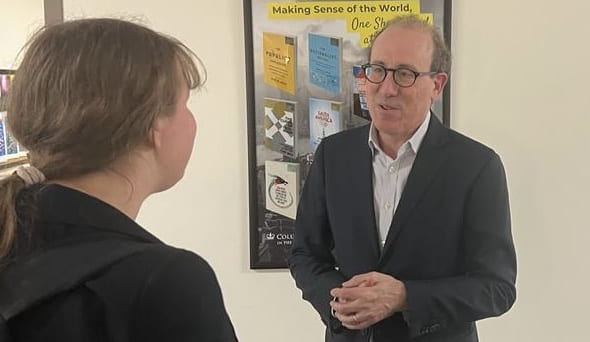Nearly 400 journalists imprisoned last year — most on flimsy charges.

NEW YORK — Last year, 363 journalists were imprisoned worldwide — an all-time high — according to annual point-in-time data collected by the Committee to Protect Journalists. In response, researchers investigated journalists’ experiences with legal attacks around the world.
Joel Simon, founding director of the Journalism Protection Initiative, co-authored a report on how the law is being weaponized around the world to silence journalists. He started the project because he realized there are many more persecuted journalists than just those who are imprisoned.
Simon co-authored the report with Carlos Lauria, a journalist and press freedom expert, and Ona Flores, an international human rights lawyer. The researchers surveyed 37 media freedom experts and 493 journalists from 106 countries, identifying 14 legal threats targeting journalists.
At a 2023 World Press Freedom Day event, Simon served on a panel alongside Lauria and Antonio Zappulla, CEO of the Thomson Reuters Foundation, to present and discuss the results of their research.
“Governments have become fantastically creative about the legal strategies they use against journalists around the world,” he said before the meeting. “These efforts are effective and a tremendous threat to press freedom and they go beyond the traditional threats that we’ve been aware of for some time.”
Reporters are facing novel charges of cyber libel and financial crimes. Cyber libel describes digital defamation. Some governments — Guatemala and Belarus, for instance — are criminalizing published online work that disagrees with their narratives. Journalists are also accosted by financial attacks such as audits and extortion accusations as well as charges of tax evasion and fraud, all to discredit them and drain their news outlet’s resources.
These types of charges are noteworthy because they are unrelated to journalistic content. For example, Guatemalan journalist José Rubén Zamora has been wrongfully imprisoned by his government since July of last year on money laundering and other financial crime allegations. Zamora’s story is gaining traction globally, including recent coverage by the New Yorker.
“[We are] seeing a whole new range of legal threats,” Simon said. “[It] is very, very alarming. The finding is that legal threats are mounting and the range of diversity of those threats is increasing. Governments and other actors that are seeking to inhibit speech are becoming more effective in using legal tools.”
As part of Simon’s research, journalists around the world recorded testimonial videos explaining the threats they were facing in their countries and communities. Each threat the report found is accompanied by testimony on the website where the report is published. The website also offers recommendations to combat legal threats and resources for journalists. Reflecting on the impact the research had on him, Simon said, “I think that just hearing journalists themselves talk about what it is to battle these kinds of legal challenges was very affective.”
In one such testimony, Glenda M. Gloria, co-founder and executive editor at Rappler, discussed the impact of ongoing legal persecution of Maria Ressa, a Filipino-American journalist. “The climate of fear is palpable, not just in the Rappler newsroom, but in other newsrooms in the Philippines,” she said. “Because if a court and the Executive Department could do something to a Maria Ressa, how much more [could they do] to the lesser known journalist out here?”


Great and important article, Berit!